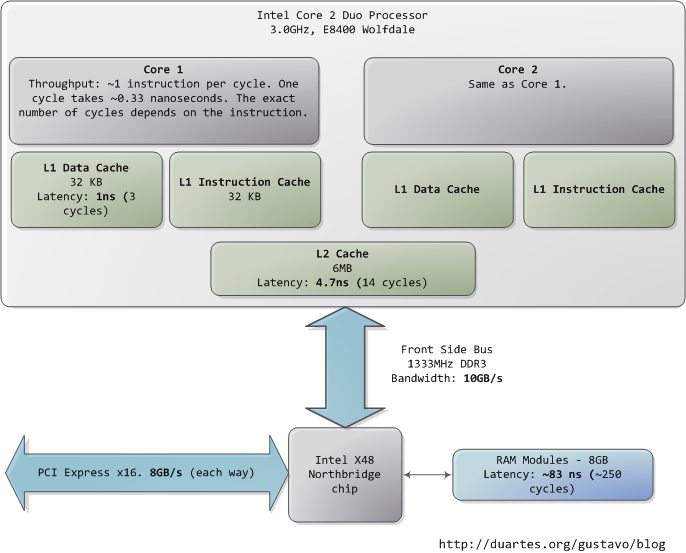Deprecated: Function create_function() is deprecated in /var/www/vhosts/interprys.it/httpdocs/wp-content/plugins/wordpress-23-related-posts-plugin/init.php on line 215
Deprecated: Function create_function() is deprecated in /var/www/vhosts/interprys.it/httpdocs/wp-content/plugins/wordpress-23-related-posts-plugin/init.php on line 215
Deprecated: Function create_function() is deprecated in /var/www/vhosts/interprys.it/httpdocs/wp-content/plugins/wordpress-23-related-posts-plugin/init.php on line 215
Cache Latency Computation is a command line application that can gather information about the cache hierarchy of your system. For each cache level, it provides its size and its latency.

Download 🔗 DOWNLOAD
Download 🔗 DOWNLOAD
Cache Latency Computation Crack + (2022)
I started CacheLatencyCompute to help the memory profiling community by easily identifying memory characteristics like L1/L2/L3/L4 caches, branch prediction buffers, TLBs, and small/large page heaps.
Just like WLKPSH, it will give you the size, latency, free/cached, and blocked statuses. Moreover, it also gives the access latency for reads/writes/etc.
It can run on any platform (Linux/Solaris/Mac) that is supported by the tool itself. You don’t need to set the option “-X” in LLDB or any other IDE or anything like that. Just run the program.
It is a MacOSX only application.
Just save this to a file name CacheLatencyCompute.app.
Run it from the Finder.
There is no technical limitation on that. It is dependant on many other software. I use it in my own projects. So I have tested it.
The program consists of a parser for DWARF (or rather, the Linux symbol tracer) output. As such, it will not work on AMD processors, for example, because they lack this information in their DWARF output.
Every tool is required to have an option and CPU option can have more than one option. So I do not understand what he means. It is the case. I am cross-platform, but I have not tested Windows.
For X86, all x86 CPUs have the register context, memory context, DWORDs and HALF_DWORDs in their DWARF output.
As the TRACE.DBG file is an ELF file format, there is no problem in reading it with regular programming. The registers are preserved or even there are no registers, after you parsed the x86 registers. So there is no problem.
When you read the.debug_info section, it is almost a simple parsing of symbol table information. If you dump this debug info output of X86 CPU, you will see the same format of.debug_info section in the ELF output.
For PPC, architecture has an additional section to represent the register context and mem context. So you cannot do a normal parsing.
The standard DWARF is mainly for debugging/logging. It does not contain the information about the hardware, etc. The x86 DWARF
Cache Latency Computation Crack+ Download
91bb86ccfa
Cache Latency Computation Crack + Activator
Here are the features :
– no dependencies (python, pyquery, selenium or…)
– command line interface
– used to gather the latency of every cache level of your machine (RAM/RAML), including cache levels that your system has no access to, such as disk,…
– you can filter your cache levels
– save to local files
– update auto-magically
– build maps for your cache sizes and latencies
– save as a diagram
– save as text report
Note that i’ll be working on porting this application to python 🙂
Installation
You need to install node and npm
sudo apt-get install nodejs sudo apt-get install npm
You can find the repo and the source code here.
… and the binary here.
Run it
I use docker to run the whole application, so when the binary is available you just need to run
docker run -it -p 8080:8080 albiq/cachelatencycomputation
and it will run.
Here is an explanation about the run flag of docker
-it : create a container for a particular user
-p : expose a port of the container to a host
The container listens on port 8080 and exposes this port to your machine.
Using this single command, you can launch it on your local machine
docker run -it -p 8080:8080 albiq/cachelatencycomputation
Or on your cloud in a few seconds by typing
docker run -it -p 8080:8080 albiq/cachelatencycomputation
Here is a youtube demo for this command
It will be your local machine or you can use containers and docker-compose to spin your own service on your laptop
You can also run locally
cachelatencycomputation.py
to launch it
if it exits
without a warning or any error, it means it worked.
Beware that this run will last a few minutes.
Exit early
If you are planning to launch this run manually for 10 seconds, or do this run multiple times in a row, you might want to exit early. The container does not have a useful IP, so it is hard to find it, that is why it has
What’s New in the Cache Latency Computation?
$ cls
List of cache levels, sorting by number of items
$ cls -L 2
$ cls -L 2
Level 0: total items =1 (0 bytes)
Level 1: total items =1 (0 bytes)
Level 2: total items =1 (0 bytes)
$ cls -L 4
$ cls -L 4
Level 0: total items =1 (0 bytes)
Level 1: total items =1 (0 bytes)
Level 2: total items =0 (0 bytes)
Level 3: total items =0 (0 bytes)
Level 4: total items =1 (0 bytes)
$ cls -L 5
$ cls -L 5
Level 0: total items =1 (0 bytes)
Level 1: total items =1 (0 bytes)
Level 2: total items =1 (0 bytes)
Level 3: total items =0 (0 bytes)
Level 4: total items =0 (0 bytes)
Level 5: total items =1 (0 bytes)
$
You can use it with Intel Performance Monitor.
Example:
In Intel Performance Monitor, right click on the Cache Latency: AgrSection and select Take screenshot.
This will generate a new image with the list of cache levels for each cache latency.
Here are the results for my 16GB-RAM-machine:What do you get when you combine a talented, multi-instrumentalist, producer and label owner, with a totally independent D.I.Y. ethic? You get Gonk. Get it? Get. It? That’s Gonk.
Created by Stasys Valtauskas (BRA) and recorded in an ordinary office in the streets of Birstall, GER, this label was created out of a passion for classic 70s soul and funk. Not content with building a small but dedicated following, Gonk also decided to make a bigger statement and created the never before seen JamBase label. Here we have some of the best producers from all over the world able to offer their best material and / or submit their D.I.Y. tracks to be released on JamBase.
Featured artists from the USA and the UK, Germany, Holland, Finland, France and Denmark’ from ‘0.
System Requirements For Cache Latency Computation:
Windows 8, Windows 7, Windows Vista
Mac OS X 10.8 or 10.7
Internet connection (for online mode)
Minimum of 512MB RAM (for online mode)
CD-ROM or USB Drive
Non-Steam Controller
Also, I’m actually working on a mod to remove the spam menu, so I’m releasing it as a standalone mod.
Download GXS2016P
First run the installation.exe and choose yes to all the prompts.
Optional, but recommended:




![SysInfoTools MS SQL Database Recovery +Активация Activation Key Скачать бесплатно [Win/Mac]](https://www.interprys.it/wp-content/plugins/wordpress-23-related-posts-plugin/static/thumbs/6.jpg)

![Logitech Connection Utility 2.20.28.0 +Активация Скачать [Latest]](https://www.interprys.it/wp-content/uploads/2022/12/logitech-setpoint-connect-utility-150x150.png)

